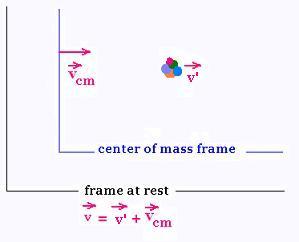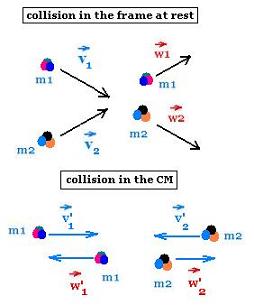Collisions
Contents
© The scientific sentence. 2010
| Center of mass & collisions
1.Definition

The velocity vi of an object, or a particle i within this object,
in the frame at rest, is equal to the velocity vcm of the center of mass (CM) plus the volocity v'i of this object or particle i in the frame of the CM, that is:
vi = vcm + v'i
2. Momentum in the frame at rest
The momentum of a particle "i" in the
frame st rest is just its mass mi times its velocity vi:
pi = mivi
The linear momentum P of the object is the sum of the linear momenta
of all the particles of this object:
P = Σ mivi
The body is rigid, the velocity
vi is the same for all these particles. It is equal
to the velocity vcm of the CM. Therefore:
P = Σ mivi = Σ mivcm =
vcmΣ mi = M vcm
Where M = Σ mi, the mass of the whole object.
P = M vcm
3. Momentum in the CM frame
The momentum of a particle "i" in the center of mass
frame is just its mass mi times its velocity v'i:
p'i = miv'i
The momentum P' of the object is:
P' = Σmiv'i =
Σmi(vi - vcm) =
Σmivi - Σmivcm =
Σmivi - Mvcm = P - P = 0.
That is:
P' = ΣP'i = 0
We recall:
The sum of the momenta in the center of mass frame
is zero.
4. Velocities after collision in the frame at rest

Now, let's consider the collision:
(m1,v1) + (m2,v2) → (m1,w1) + (m2,w2)
in the frame at rest,
and
(m1,v'1) + (m2,v'2) → (m1,w'1) + (m2,w'2)
in the CM frame, we have:
4.1. Collision in the CM
In the CM, we have:
P' = Σp'i = p'1 + p'2 = 0
before collision.
Q' = Σq'i = q'1 + q'2 = 0
after collision.
Therefore:
p'1 = - p'2 before collision, and
q'1 = - q'2 after collision
The conservation of the kinetic energy gives:
p'12/2m1 + p'22/2m2
= q'12/2m1 + q'22/2m2
p'12/2 [1/m1 + 1/m2] =
q'12/2 [1/m1 + 1/m2]
(1/2) [1/m1 + 1/m2] [p'1 2 -
q'12] = 0
We have then two possibilities:
p'1 = + q'1 and
p'2 = + q'2
or
p'1 = - q'1 and
p'2 = - q'2
The first says that is no collision, and the second
shows that the momenta of both objects reverse their
directions. Since the masses do not change, we have for
the related velocities:
v'1 = - w'1 and
v'2 = - w'2
We recall:
In the center of mass frame of two objects, the
collision just reverses the direction of these two
objects.
We have:
vcm = [m1v1 +
m2v2]/M
M = m1 + m2
Then:
v'1 = v1 - vcm =
v1 - [m1v1 +
m2 v2 ]/M =
(1/M)[m1v1 +
m2v1 - m1v1
- m2 v2] =
(m2/M)[v1 - v2]
Hence:
w'1 = - (m2/M)[v1 - v2]
Therefore:
w1 = w'1 + vcm =
- v'1 + vcm = - v1 + 2vcm
w1 = - v1 + 2vcm
w2 = - v2 + 2vcm
That is:
w1 = v1(m1 - m2)/M + v2 2m2/M
w2 = v2(m2- m1)/M + v1 2m1/M
w1 = v1(m1 - m2)/M + 2v2 m2/M
w2 = v2(m2- m1)/M + 2v1 m1/M
5. Energy in the CM frame

P' = p'1 + p'2 = 0 before explosion
Q' = q'1 + q'2 = 0 after explosion
Before the explosion, the total energy of the object in the
center of mass frame is zero (because the original body was
at rest in this frame) After the explosion,
the total energy in this frame is:
E' = q'12/2m1 + q'22/2m2
= q'12 [1/2m1+ 1/2m2]
Therefore:
q'1 2= 2 m1m2E'/(m1 + m2)
Then:
w'2 = [q'22]1/2/m2 =
[2 m1E'/m2M]1/2
w'2 = [2 m1E'/m2M]1/2
Similarly,
m1 w'1 = - m2 w'2
Then:
w'1 = - m2 w'2/m1 =
- [2 m2E'/m1M]1/2
w'2 = [2 m1E'/m2M]1/2
w'1 = - [2 m2E'/m1M]1/2
w'2 = [2 m1E'/m2M]1/2
w'1 = - [2 m2E'/m1M]1/2
Using :
vcm = v
w1 = w'1 + vcm
w2 = w'2 + vcm ,
we can write:
w1 = w'1 + vcm
w2 = w'2 + vcm
Etotal = (1/2)m1 w12 +
(1/2)m2 w12 =
m1 w12 = m1[w'1 + vcm]2
and
m2 w22 = m2[w'2 +
vcm]2,
According to:
w'1 = - m2 w'2/m1
,
we have:
m2 w2 2 =
m2[(- m1w'1/m2) + vcm]2 =
m2[ 2 m1E'/m2M + vcm]2
Then:
m1 w12 + m2 w22 =
m1[ w'12 + vcm2 + 2w'1vcm] +
m2 [ (- m1w'1/m2)2 +
vcm 2 -
2 m1w'1vcm/m2 ]
Rearranging gives:
m1 w12 + m2 w22 =
m1[ w'12 + vcm2 ] +
m2 [ (- m1w'1/m2)2 + vcm2]
= m1 w'1 2 +
m2 w'22
+ (m1 + m2)vcm2 =
2E' + Mvcm2 .
Let
Etotal = (1/2)[
m1 w12 + m2 w22]
Then
Etotal = E' + (1/2) Mvcm2
Etotal = E' + (1/2) Mvcm2
E' = (1/2) [m1w'12 + m2w'22]
The total kinetic energy of a system is equal to the
kinetic energy of the center of mass plus the sum
of the kinetic energies of the objects of the sytem,
as calculated in the center of mass frame.
6. Other way to express directly the total energy
vi = vcm + v'i
Etotal = Σ (1/2)mivi2 =
Σ (1/2)mi(vcm + v'i)2 =
Σ (1/2)mi[vcm2 + v'i2+ 2 v'ivcm] =
(1/2) Σ mi[vcm2 + v'i2+ 2 v'ivcm]
We have:
(1/2) Σ mi [2 v'ivcm] =
vcmΣ mi v'i = vcmΣ p'i = 0
It remains:
Etotal = (1/2) Σ miv2cm + (1/2) Σ miv'i2
= (1/2)M v2cm + (1/2) Σ miv'i2
= Ecm + E'
Etotal = Ecm + E'
Etotal = Σ (1/2)mivi2
E' = Σ (1/2) miv'i2
Ecm = (1/2)M v2cm
Etotal = Ecm + E'
M = Σ mi
7. Example:
For the head-on collision in the rest frame:
(m,V) + (M,0) → m w1+ Mw2, we
have:
w = 2m/(m+M)
w'2 = w2 - vcm
vcm = mV/(m + M), so
w'2 = w2 - mV/(m + M) = mV/(m + M)
Therefore:
w'22 = m2V2/(m + M)2
= 2mE' /M(m + M), so
E' = (1/2) m V2 M/(m + M)
If K is the kinetic energy = (1/2) mV2 of the
projectile (m,V), we have:
E' = K M/(m + M)
Collision: (m,V) + (M,0)
The enrgy available to cause reaction is
E' = K M/(m + M)
Collision: (m,V) + (M,0)
The energy available to cause reaction is:
E' = K M/(m + M)
K is the projectile's kinetic energy = (1/2) mV2
|
|